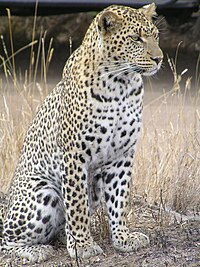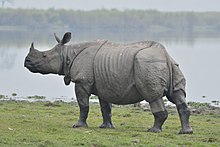Subspecies




In biological classification, the term subspecies refers to one of two or more populations of a species living in different subdivisions of the species' range and varying from one another by morphological characteristics.[2][3] A single subspecies cannot be recognized independently: a species is either recognized as having no subspecies at all or at least two, including any that are extinct. The term may be abbreviated to subsp. or ssp. The plural is the same as the singular: subspecies.
In zoology, under the International Code of Zoological Nomenclature, the subspecies is the only taxonomic rank below that of species that can receive a name. In botany and mycology, under the International Code of Nomenclature for algae, fungi, and plants, other infraspecific ranks, such as variety, may be named. In bacteriology and virology, under standard bacterial nomenclature and virus nomenclature, there are recommendations but not strict requirements for recognizing other important infraspecific ranks.
A taxonomist decides whether to recognize a subspecies. A common criterion for recognizing two distinct populations as subspecies rather than full species is the ability of them to interbreed even if some male offspring may be sterile.[4] In the wild, subspecies do not interbreed due to geographic isolation or sexual selection. The differences between subspecies are usually less distinct than the differences between species.
Nomenclature[]
The scientific name of a species is a binomial or binomen, and comprises two Latin words, the first denoting the genus and the second denoting the species.[5] The scientific name of a subspecies is formed slightly differently in the different nomenclature codes. In zoology, under the International Code of Zoological Nomenclature (ICZN), the scientific name of a subspecies is termed a trinomen, and comprises three words, namely the binomen followed by the name of the subspecies.[6] For example, the binomen for the leopard is Panthera pardus. The trinomen Panthera pardus fusca denotes a subspecies, the Indian leopard.[1] All components of the trinomen are written in italics.[7]
In botany, subspecies is one of many ranks below that of species, such as variety, subvariety, form, and subform. To identify the rank, the subspecific name must be preceded by "subspecies" (which can be abbreviated to "subsp." or "ssp."), as in Schoenoplectus californicus subsp. tatora.[8]
In bacteriology, the only rank below species that is regulated explicitly by the code of nomenclature is subspecies, but infrasubspecific taxa are extremely important in bacteriology; Appendix 10 of the code lays out some recommendations that are intended to encourage uniformity in describing such taxa. Names published before 1992 in the rank of variety are taken to be names of subspecies[9] (see International Code of Nomenclature of Prokaryotes). As in botany, subspecies is conventionally abbreviated as "subsp.", and is used in the scientific name: Bacillus subtilis subsp. spizizenii.[10]
Nominotypical subspecies and subspecies autonyms[]
In zoological nomenclature, when a species is split into subspecies, the originally described population is retained as the "nominotypical subspecies"[11] or "nominate subspecies", which repeats the same name as the species. For example, Motacilla alba alba (often abbreviated M. a. alba) is the nominotypical subspecies of the white wagtail (Motacilla alba).
The subspecies name that repeats the species name is referred to in botanical nomenclature as the subspecies "autonym", and the subspecific taxon as the "autonymous subspecies".[12]
Doubtful cases[]
When zoologists disagree over whether a certain population is a subspecies or a full species, the species name may be written in parentheses. Thus Larus (argentatus) smithsonianus means the American herring gull; the notation within the parentheses means that some consider it a subspecies of a larger herring gull species and therefore call it Larus argentatus smithsonianus, while others consider it a full species and therefore call it Larus smithsonianus (and the user of the notation is not taking a position).[citation needed]
Criteria[]
A subspecies is a taxonomic rank below species – the only such rank recognized in the zoological code,[13] and one of three main ranks below species in the botanical code.[12] When geographically separate populations of a species exhibit recognizable phenotypic differences, biologists may identify these as separate subspecies; a subspecies is a recognized local variant of a species.[14] Botanists and mycologists have the choice of ranks lower than subspecies, such as variety (varietas) or form (forma), to recognize smaller differences between populations.[12]
Monotypic and polytypic species[]

In biological terms, rather than in relation to nomenclature, a polytypic species has two or more genetically and phenotypically divergent subspecies, races, or more generally speaking, populations that differ from each other so that a separate description is warranted.[15] These distinct groups do not interbreed as they are isolated from another, but they can interbreed and have fertile offspring, e.g. in captivity. These subspecies, races, or populations, are usually described and named by zoologists, botanists and microbiologists.[citation needed]
In a monotypic species, all populations exhibit the same genetic and phenotypical characteristics. Monotypic species can occur in several ways:[citation needed]
- All members of the species are very similar and cannot be sensibly divided into biologically significant subcategories.
- The individuals vary considerably, but the variation is essentially random and largely meaningless so far as genetic transmission of these variations is concerned.
- The variation among individuals is noticeable and follows a pattern, but there are no clear dividing lines among separate groups: they fade imperceptibly into one another. Such clinal variation always indicates substantial gene flow among the apparently separate groups that make up the population(s). Populations that have a steady, substantial gene flow among them are likely to represent a monotypic species, even when a fair degree of genetic variation is obvious.
See also[]
- Breed
- Glossary of scientific naming
- Cultivar in botany
- Form (botany)
- Form (zoology)
- Landrace
- Polymorphism (biology)
- Race (biology)
- Strain (biology)
- Variety (botany)
- Species complex
References[]
Citations[]
- ^ Jump up to: a b c Kitchener, A. C.; Breitenmoser-Würsten, C.; Eizirik, E.; Gentry, A.; Werdelin, L.; Wilting, A.; Yamaguchi, N.; Abramov, A. V.; Christiansen, P.; Driscoll, C.; Duckworth, J. W.; Johnson, W.; Luo, S.-J.; Meijaard, E.; O’Donoghue, P.; Sanderson, J.; Seymour, K.; Bruford, M.; Groves, C.; Hoffmann, M.; Nowell, K.; Timmons, Z.; Tobe, S. (2017). "A revised taxonomy of the Felidae: The final report of the Cat Classification Task Force of the IUCN Cat Specialist Group". Cat News. Special Issue 11: 66−69. hdl:10088/32616.
- ^ Mayr, E. (1982). "Of what use are subspecies?". The Auk. 99 (3): 593−595.
- ^ Monroe, B. L. (1982). "A modern concept of the subspecies". The Auk. 99 (3): 608−609.
- ^ "Species - Speciation". Encyclopedia Britannica. Retrieved 2021-04-20.
- ^ Linné, C. (1735). Systema naturae, sive, Regna tria naturae systematice proposita per classes, ordines, genera, & species. Lugduni Batavorum: Theodor Haak.
- ^ Ride, W. D. L.; Corliss, J. O., eds. (1999). International Code of Zoological Nomenclature: Adopted by the International Union of Biological Sciences (PDF) (Fourth ed.). London: The International Trust for Zoological Nomenclature. ISBN 0853010064.
- ^ "Scientific Nomenclature". cdc.gov. Centers for Disease Control and Prevention. Retrieved 20 January 2021.
- ^ James, Mallet. "Subspecies, semispecies, superspecies" (PDF). ucl.ac.uk. Retrieved 27 April 2018.
- ^ "Chapter 3: Rules of Nomenclature with Recommendations". National Center for Biotechnology Information. Retrieved January 17, 2013.
- ^ Parker, Charles T.; Tindall, Brian J.; Garrity, George M. (20 November 2015) [2008]. "International Code of Nomenclature of Prokaryotes (2008 Revision)". International Journal of Systematic and Evolutionary Microbiology (ICSP Matters ed.). 69. "Names of Subspecies: Rule 13a". doi:10.1099/ijsem.0.000778. PMID 26596770. Full text available from PDF link at this page; direct URL to PDF is auto-generated and expires.
- ^ International Code of Zoological Nomenclature, Art. 47
- ^ Jump up to: a b c McNeill, J.; Barrie, F. R.; Buck, W. R.; Demoulin, V.; Greuter, W.; Hawksworth, D. L.; Herendeen, P. S.; Knapp, S.; Marhold, K.; Prado, J.; Prud'homme Van Reine, W.F.; Smith, G. F.; Wiersema, J. H.; Turland, N. J. (2012). International Code of Nomenclature for algae, fungi, and plants (Melbourne Code) adopted by the Eighteenth International Botanical Congress Melbourne, Australia, July 2011. Regnum Vegetabile 154. A.R.G. Gantner Verlag KG. ISBN 978-3-87429-425-6.
- ^ Rosenberg, Gary; et al. (eds.). "ICZN Glossary". International Code of Zoological Nomenclature. International Commission on Zoological Nomenclature.
- ^ Russell, Peter J.; Hertz, Paul E.; McMillan, Beverly (2011). "21: Speciation". Biology: The Dynamic Science. Brooks/Cole California. p. 456. ISBN 978-1133418849.
- ^ Mayr, E. (1970). Populations, Species, and Evolution: An Abridgment of Animal Species and Evolution. Harvard University Press.
Sources[]
- Barrow, M. V. (1998). A Passion for Birds: American Ornithology after Audubon. Princeton, NJ: Princeton University Press. ISBN 9780691044026.
- Lewis, D. (2012). The Feathery Tribe: Robert Ridgway and the Modern Study of Birds. New Haven, CT: Yale University Press. ISBN 9780300175523.
- Mayr, E.; Ashlock, P. D. (1991). Principles of Systematic Zoology (Second ed.). New York, NY: McGraw-Hill Inc. ISBN 978-0-07-041144-9.
External links[]
 The dictionary definition of subspecies at Wiktionary
The dictionary definition of subspecies at Wiktionary
- Subspecies
- Botanical nomenclature
- Plant taxonomy
- Zoological nomenclature
- Biology terminology